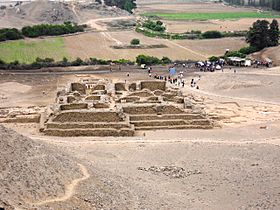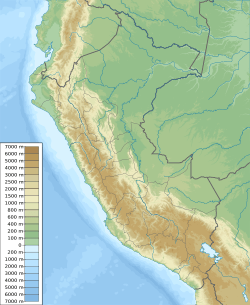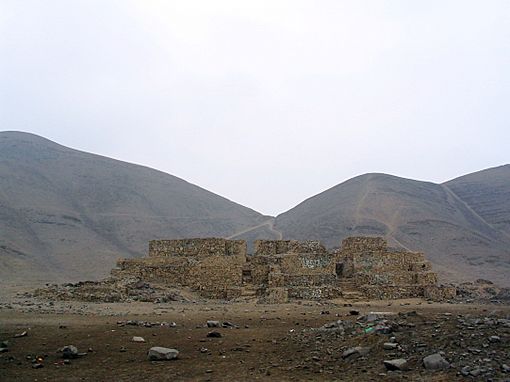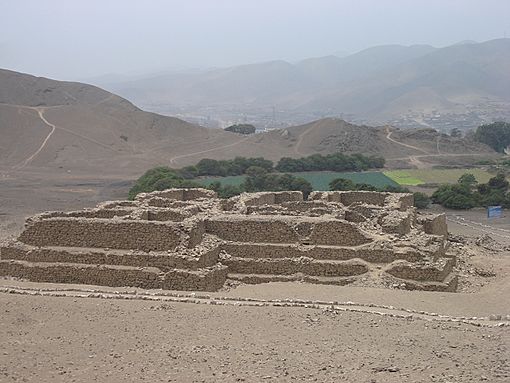El Paraíso, Peru facts for kids

Main pyramid at El Paraíso.
|
|
| Location | San Martin de Porres, Chillon River Valley, Peru |
|---|---|
| Region | Chillon River Valley |
| Coordinates | 11°57′13.68″S 77°7′6.39″W / 11.9538000°S 77.1184417°W |
| History | |
| Founded | 3790 cal. B.P. |
| Abandoned | 3065 cal B.P. |
| Periods | Cotton Preceramic |
| Site notes | |
| Excavation dates | 1960s, Frédérick Engel; 1980s Jeffrey Quilter |
| Archaeologists | Jeffrey Quilter, Ripon College, Wisconsin ? |
| Architecture | |
| Architectural details | Number of monuments: 10 |
| Responsible body: Ministry of Culture, Peru | |
El Paraíso (meaning "The Paradise") is an ancient archaeological site in Peru. It is located near the Chillón River, just north of Lima, the capital city. This site is one of the biggest settlements from a time called the Late Preceramic period (around 3500–1800 BC). It covers a large area of more than 58 hectares.
Other important ancient sites from this time include Aspero and Caral. These sites show that people lived in many different environments, from the coast to inland areas. This allowed them to use various resources from the sea and from farming.
Contents
A Look at El Paraíso's History
El Paraíso was used for a relatively short time, about 300 to 400 years. This was from about 3790 to 3065 years ago. Most archaeologists agree it was mainly a Preceramic site. This means people lived there before pottery was widely used.
Some researchers call this period the "Cotton Preceramic." This is because cotton was a very important crop. However, some experts, like Pozorski and Pozorski, think El Paraíso was mostly used during the early Initial Period. By this time, some areas did have pottery. Since El Paraíso didn't use pottery much, they call it an "aceramic" site.
The exact purpose of El Paraíso is not fully clear. There isn't much evidence of it being a place where many people lived. Instead, it might have been a center for trade or religion, or both. It could also have been a main place for growing and processing cotton.
The site's layout is shaped like a "U," with a large open area (plaza) in the middle. This U-shape is similar to later sites in the region. So, El Paraíso might have been an early example of this type of building design.
Experts believe that building El Paraíso required a complex social structure. It suggests a "chiefdom" society. This means there wasn't one central ruler. Instead, different groups worked together on big projects.
Unlike some other sites, El Paraíso was not part of a large, connected civilization like the Caral-Supe civilization. It was more isolated. Some theories suggest that early Peruvian societies relied heavily on rich ocean resources. El Paraíso supports this idea.
The Preceramic period in the Andes is known for not having pottery. During this time, societies along the Peruvian coast became more complex. They started building large structures. Trade and interactions between different groups also increased. It's estimated that between 1,500 and 3,000 people lived at El Paraíso.
El Paraíso wasn't destroyed suddenly. It seems people slowly left the site. There's no clear reason why it was abandoned. Also, there's no sign that people moved back to live there later.
Exploring El Paraíso: Research and Discoveries
Archaeologists have studied El Paraíso for many years. Here's a timeline of some key research:
- 1950s: Louis Stumer explored the Chillón Valley. He first called the site Chuquitanta.
- 1964: Thomas C. Patterson and Edward P. Lanning published their findings. They noted it was a Preceramic site.
- 1965: Fréderick Engel began digging at the site. He mapped it and restored one of the main buildings, Unit I. He renamed the site El Paraíso. Engel confirmed it was Preceramic because he found no pottery, only old textiles.
- 1968: Thomas C. Patterson and Michael E. Moseley identified many buildings, possibly between nine and thirteen.
- 1982: Jeffrey Quilter started a long-term study called El Proyecto Bajo Valle del Chillón.
- 1983: Jeffrey Quilter focused his efforts on El Paraíso. He wanted to understand its timeline, buildings, and how people got their food.
Digging into the Site
Even though El Paraíso is very important, not a lot of archaeological digging has happened there. Louis Stumer first mentioned the site in the 1950s. He called it Chuquitanta. Later, Fréderick Engel changed its name to El Paraíso.
Early work suggested the site was Preceramic. This was later confirmed by radiocarbon dating. This method uses carbon to find the age of ancient materials. Jeffrey Quilter's work placed the site in the later part of the Preceramic period.
Two main excavation projects have taken place. Engel led the first digs in the 1960s. Quilter followed up in the 1980s. He led a large project to study the lower Chillón valley.
It's been hard to count the exact number of buildings at the site. This is because modern farming equipment and roads have damaged the area. In 1983, a survey found eleven buildings. Seven of these were still standing.
Engel's Excavations
Engel's work focused on Unit I. He even rebuilt some of its walls. Quilter later re-examined this building in 1984. He also dug in Units II and IV, and other spots around the site.
Archaeologists found many interesting items. These items tell us about the daily life, social customs, and beliefs of the people. Five burials were found at the site by Engel. These burials were found near buildings. It's hard for researchers to learn much from them. However, in later Andean cultures, child burials were sometimes linked to rituals for good harvests.
Unit II contained pieces of cloth and other household trash. Unit IV mostly had food remains. It seems the people of El Paraíso buried most of their trash in pits. These pits were often outside buildings or sometimes inside rooms.
Ancient Textiles and Tools
Many textile pieces were found. They were mostly made of cotton in natural colors like white to dark brown. But some were dyed deep red or blue. Other sites from this period also show that people dyed cotton in bright colors like yellow, green, and orange.
Archaeologists also found two objects with dark blue stone inlays, possibly lapis lazuli. Other items included mats, bags, nets, and tools made of wood and bone. They also found grinding stones, stone beads, and even a polished stone mirror.
Mysterious Bird Remains
One exciting discovery was bird remains in Unit II. An immature seabird skeleton was found carefully placed with small fish and crab remains. It was next to a handprint in mortar. Another bird skeleton was found with carefully arranged sticks. Large amounts of bird droppings (guano) and feathers were also found.
These findings suggest that birds were important at El Paraíso. They might have been used for ceremonies. The room where these bird remains were found also had cotton, wood, and needles. This suggests that feathers might have been used to make special textiles or items for rituals.
Another ritual item was found inside a wall in Unit I. It was a large stone offering, similar to later Inka huacas (sacred rocks). It was covered in red paint and wrapped in cotton cloth. It was found with gourds containing food and a small bag filled with white lime cakes wrapped in leaves. This suggests that chewing leaves with lime, like later coca use, is a very old tradition.
Later Visitors
Some pottery pieces from a later period (the Initial or Ceramic period) were found on the surface. This suggests that people briefly visited or lived at the site much later. However, it doesn't seem like there was any major activity during this time.
Temple Discovery in 2013
In 2013, archaeologists found the remains of a temple in the main pyramid. It might be as old as 3000 BC. This stone temple measures about 6.8 by 8 meters. Its yellow clay walls still show traces of red paint. A hearth (fireplace) was found in the center. Mark Guillen, who led the expedition, said, "The main characteristic of their religion was the use of fire. The smoke allowed the priests to connect with their gods."
The El Paraíso Site and Its Surroundings
El Paraíso is located about two kilometers inland from the Pacific Ocean. It sits on the flood plain of the Chillón River. The area around it has over 90 hectares of farmland. Another 150 hectares of lowlands could also be farmed with irrigation.
El Paraíso is one of six Preceramic sites in the Ancón-Chillón Valley. Other sites include Pampa de los Perros and Buena Vista. Ancon (archaeological site) is another important nearby site. El Paraíso is just north of other ancient sites like La Florida.
How Old Is It?
El Paraíso was used from about 3790 to 3065 years ago. This places it firmly in the Preceramic Period. The oldest dates come from Unit 4, around 2540 BC.
Unit 1, which was dug up and rebuilt by Frederic Engel, is a very important structure. Dates from Unit 1 range from 2320 BC to 1105 BC. Most samples come from Room 2, which is thought to be the oldest and largest room in Unit 1.
Most of the dates come from wood charcoal found in ancient trash heaps (midden). Later materials, from about 200 BC to 550 AD, have also been found. These show that the abandoned site was visited again for short periods much later.
The Buildings of El Paraíso
Site Layout
The buildings at El Paraíso have been studied closely. In 1965, Engel identified seven main structures, calling them Units I-VII. Quilter's team found five more in 1983. Unfortunately, modern farming and roads have damaged parts of the site. Because of this, we don't know the exact connection between some buildings. For example, Unit III, which looks like a pile of rubble, might actually be two collapsed buildings. Also, part of Unit VI, one of the largest structures, is now under a brick storage yard.
The general layout of El Paraíso is different from other Preceramic sites nearby. Other sites often have a "U-shape" where the largest building is at the bottom of the "U." This building is usually the tallest and biggest. At El Paraíso, the buildings forming the sides of the "U" are larger than the one at the bottom. They are also similar in height and length.
El Paraíso's location is also unique. Other sites are usually built overlooking large fields and the Pacific Ocean. But at El Paraíso, hills block the view of the ocean. The site also doesn't overlook the largest nearby fields. This might suggest that the people here focused more on river resources than ocean ones.
Unit I
Unit I is at the southern end of the site. It was built using rough stones from a nearby hill. These stones were held together with mortar and covered in plaster. The building has four levels, showing it was built in several stages. During construction, rooms were filled with fiber bags full of rocks. Doorways and stairways inside show that the building's use changed over time.
Room 2 is the oldest part of this complex. Digging here found four different floors, each separated by layers of black trash. The earliest layer is dated to 2185 to 1685 BC. The latest is from 1420 to 1105 BC. The last stage of use suggests it was for ceremonies. The most important find here was a ritual offering placed inside one of the walls.
Archaeologists believe there was a complex way of controlling space in Unit I. The rooms in the northwest could be easily reached from outside with wide staircases. But the rooms in the southern half could only be reached through a single staircase or long, narrow hallways.
Unit II
Like Unit I, Unit II has many plaster floors and signs of different building stages. The top layers showed a clay floor with pottery from a later period. Deeper down, two parallel lines of stone were found, possibly walls. Unique columns built into the walls were found in one of the smaller rooms. These features haven't been seen at other Preceramic sites on the Peruvian coast.
Room 1, a 5-meter square room, was also excavated. The upper layers had pottery pieces, cloth, and household trash. This suggests it was used for many different activities. A small fireplace was found underneath. The bird remains mentioned earlier were also found here. The mix of items suggests many different activities took place in this room.
Unit IV
Unit IV is a single-story building that had been disturbed by looters. Archaeologists dug next to the disturbed area. They found a clay floor and many animal remains. Instead of being a living area, Unit IV might have been a place for feasts connected to Unit I.
Sad Damage in 2013
In June 2013, one of the pyramids at El Paraíso was sadly destroyed. Property developers used bulldozers to knock down the building and then set the remains on fire. Police stopped them from destroying 11 other pyramids at the site. Before it was destroyed, this pyramid was about 2,500 square meters in size and 6 meters tall.
Food from the Sea
The people of El Paraíso were "maritime-adapted hunter-gatherers." This means they were skilled at getting food from the sea. Seafood made up most of their diet. Archaeologists look for food remains and tools to understand what people ate. At El Paraíso, they found many fish, shellfish, and seabird remains. They also found tools for fishing and hunting sea animals. This shows that the people relied heavily on the ocean.
This is important because it supports a theory about early Peruvian civilization. This theory suggests that these early societies grew strong because of rich seafood resources. They didn't rely only on farmed plants and animals. Analysis of animal remains showed that fish was the main source of protein. Anchovies were the most common fish. Clams were the most common shellfish, but they provided less protein. Studies of ancient human waste (coprolites) also showed that fish and crawfish were a big part of their diet.
How Society Was Organized
Normally, the cold Humboldt Current flows along the Peruvian coast. It brings many nutrients, which leads to a lot of marine life. But every few centuries, an El Niño event happens. This changes the current, causing very few marine animals to be available. During such hard times, a priestly class might have appeared. They would have provided leadership and prayed to the gods for help.
We don't have direct proof of powerful leaders at El Paraíso, like special burials with fancy clothes or jewelry. However, the size and complexity of the site suggest that some kind of leadership was needed. Building such a large site required many people working together. It also suggests that people had specialized jobs, like making bricks.
Archaeologists found that El Paraíso was built using careful plans and measurements. This means it wasn't just a random collection of buildings. It was well-planned. This suggests that a hierarchy (a system of ranking people) was needed to plan the site and organize the large workforce. But the exact details of their social structure are still a mystery.
The Environment of El Paraíso
El Paraíso is located near the mouth of the Chillón River Valley, about 2 kilometers from the Pacific Ocean. The average temperature is around 21°C (70°F), ranging from 13°C (55°F) to 32°C (90°F). El Paraíso is in a river valley, which provides rich resources. It is surrounded by dry desert land. There's a large flood plain nearby that supports cotton fields.
The Pacific Ocean brings the Humboldt Current. This current creates a rich and diverse marine life. It also helps lush tropical plants grow. The Humboldt Current was likely a very important food source before farming became common on the coast.
Scientists believe the climate in Peru today is similar to what it was 4,000 to 5,000 years ago. Studies have found mollusc remains that show at least two major El Niño events happened while El Paraíso was active. El Niño would have changed the types and amounts of available food. However, it seems people were able to survive by eating remaining marine life and the plants that grew during El Niño events.
What People Ate
The people of El Paraíso ate a mix of farmed and wild foods. Their economy was quite simple. They found many non-farmed foods, which means there were enough wild resources to hunt or gather. Wild plants like sedge roots, groundcherries, and cattails might have been a big part of their diet.
More than 90% of their protein came from marine resources. This was mostly fish and shellfish. Based on the number of individual animals found, anchovies were the most common fish. Mussels were the most common shellfish. Very few land animals were found at El Paraíso. This strong focus on marine resources might have meant they didn't need a complex farming system for food.
Cotton was grown to make nets for fishing and clothes for the people. This shows that industrial farming (growing crops for specific uses) was important to their way of life.
Farming at El Paraíso
Farming slowly became part of life at El Paraíso. This was because there were so many marine organisms available. So, farming was mainly for industrial resources, like cotton. The earliest farmed plants were cotton (Gossypium barbadense) and bottle gourd (Lagenaria siceraria), dating back to 2500 BC.
Other farmed plants included squash, chili pepper, common bean, achira, and jicama. They also ate fruits like guava, lucuma, and pacay. This shows they had a varied diet and managed some wild crops. Some findings suggest that plants like nightshades and potatoes might have also been farmed.
Cotton was one of the most important crops. It was used to make nets and lines for catching fish. It was also used to make textiles for clothing.
Images for kids
See also
 In Spanish: Huaca El Paraíso para niños
In Spanish: Huaca El Paraíso para niños







